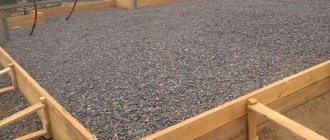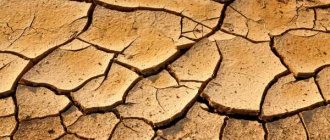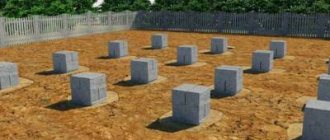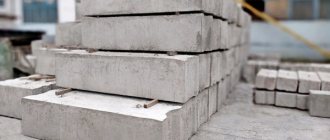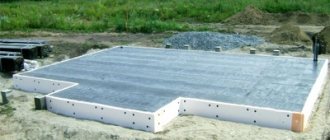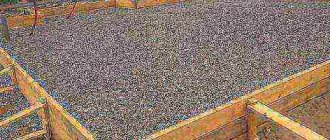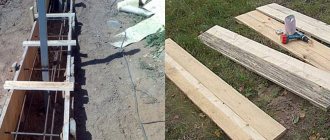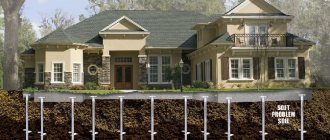Different foundations are laid for different structures. The foundation is the basis of the future structure; the service life of the entire structure depends on its design features. However, this basis also requires its own sub-foundation. The integrity of the foundation of the future house depends on the type of soil on which it is placed. Both in the case when there are strong stable soils under the future building, and when there are loams under the house, a cushion for the foundation is organized.
It is recommended to lay it under any foundation, regardless of its size and depth. It is very important to select your own sub-base for a specific type of foundation so that it fully fulfills the tasks assigned to it.
Pillow under the stove
Why do you need a pillow under the foundation?
A foundation cushion is an artificial foundation made of gravel, sand, concrete, reinforced concrete blocks, which is not part of the foundation structure, but replaces part of the soil underneath it. The pillow performs a number of functions.
Table 1. Functions performed by the foundation cushion.
| Function performed | Description |
| Alignment | Should level the bottom of the trench. It is necessary to construct a substructure for prefabricated and slab foundations. When laying a shallow belt under low buildings, a layer of gravel or even compacted sand performs this function |
| Protection against ground movements | Protects the foundation from seasonal soil movements. When pouring a layer of sand or gravel onto weak and heaving soils, the bearing capacity of the soil increases, which ensures a reliable foundation |
| Drainage | Prevents moisture from rising from the soil into the foundation and drains rainwater to the side |
| Frost heave protection | Preventing the foundation from being pushed out of the ground by expanding water |
| Reducing building shrinkage processes | Creates a stronger support under the object |
| Increasing the stability of the structure | Especially appreciated in seismologically troubled areas |
Separately, I would like to focus attention on the phenomenon of frost heaving , which is protected from by a sub-base that is denser than soil. This phenomenon is especially typical for clay soils . Clay soils freeze unevenly in winter, increasing in volume by up to 9% .
Moreover, throughout the winter, clay sucks up moisture from the lower horizons of the soil, increasing in volume even more. Moreover, if the groundwater level is high, then the clay can swell up to tens of centimeters and lift a house, a road and even a railway track. As a result of this effect of frost heaving, the foundation can easily crack in the spring. A base made of coarse sand, crushed stone or sand-gravel mixture, which performs a shock-absorbing and drainage function, will save you from the effects of destructive forces.
The effect of frost heaving
Minimum figures according to SNIP, SP
SNiP 2.02.01-83 SP 50-101-2004 the minimum height of the entire foundation structure, taking into account all layers, will be no less than 0.6 m
Subject to compliance with the rules of SNiP and SP, the lowest value of the parameter can be used if concrete of a grade not lower than M300 with a strength of B22.5 is selected.
In order to provide the necessary reserve strength, the developer must reinforce the slab, which will ultimately allow the foundation to be resistant to deforming influences from the soil.
Choosing an unreasonably thick slab will not only lead to excessive consumption of material and labor resources. Significant pressure from the house together with a monolithic foundation will over time be accompanied by subsidence of the structure in the ground.
Excessively “light” pressure, in turn, will lead to the fact that the slab will move at the slightest movement of the soil (for example, when the ground thaws in the spring), reducing the service life of the entire building.
Types of pillows for the foundation
Let's look at the main types of foundation pillows.
sand cushion
A sand cushion is a very common type of base for tape, especially for one-story buildings due to the availability and low cost of the building material. For its construction, coarse-grained river or quarry sand is taken. When calculating the volume of building material, you need to add approximately 15% for compaction. Sand has its advantages:
- drains rain well;
- absorbs groundwater;
- acts as a shock absorber during heaving;
- increases the thermal insulation properties of the structure;
- compacts well.
Benefits of a sand cushion
The sand base is most often chosen in the following cases:
- for light and one-story buildings: houses, garages, outbuildings;
- when it is necessary to replace loose soil under the foundation with more compacted one;
- under shallow foundations to cut off capillary suction.
The dimensions and thickness of the sand base are selected based on the type of soil, number of floors and building material, and soil characteristics. The thickness of the sand base under the tape depends on its width. 15 cm thick is poured under the slab 30 cm thick under piles and pillars , in addition it should be wider than the size of the pillars by 15-20 cm in circumference. On clay soils, the thickness of the cushion can reach half a meter . In this case, sand is poured in layers of 15-20 cm and each layer is spilled and compacted.
Advice! Experts do not recommend making a very thick base, since it is difficult to predict how it will behave in extreme conditions.
sand cushion
In addition, to install a high-quality sub-base in a place with high groundwater level, you will need waterproofing material , for example, geotextiles or roofing felt. The fact is that sand absorbs water very well, which, without waterproofing, will rise through the pores of the foundation concrete up into the walls. Geotextiles are laid both under the sand layer and on top. The layers laid on it are pre-compacted with a tamper. For better compaction, it is better to water the sand.
Gravel bed
The crushed stone cushion is also very popular due to its simple backfill technology and greater strength than sand. Crushed stone for these purposes can be taken of two types: gravel and granite. Limestone is not suitable for such tasks due to its low quality .
Gravel is a type of crushed stone obtained by sifting quarry or river sand. Crushed gravel is used in 90% of cases for backfilling the foundation. It has a more affordable price compared to granite. Crushed gravel has a rounded grain shape.
Gravel absorbs less water than sand and can withstand greater loads . Thanks to this feature, the crushed stone cushion can serve as a base for the foundation of two- and even three-story buildings. In terms of cost, this option will be more expensive than sand backfill.
Prices for granite crushed stone
Crushed granite
Video - How to compact crushed stone
To make the pillow, a crushed stone fraction of 20-40 mm with a strength of M1200 . This is a frost-resistant building material, which is especially important. Crushed stone is poured onto a sand bedding and compacted. If a thick layer of gravel is needed, then it is poured and compacted, like sand, layer by layer. Liquid bitumen compounds are used as waterproofing , since rolled and fabric materials can be damaged by the sharp edges of crushed stone.
Note! A number of experts believe that the use of waterproofing is not justified and can only lead to higher construction costs at low groundwater levels.
Experience is used to justify the method. If you take 2 glass containers and fill one third with water, and then carefully pour sand into one, and gravel into the second, then the humidity in the sand will rise much higher than the water level, while in the container with gravel it will remain in the same place. This is because gravel does not absorb water as much as sand.
Combined sand and gravel cushion - step-by-step installation instructions
Quite often, builders fill in a combined bed of sand and crushed stone. The requirements for building materials remain the same: coarse river or quarry sand without clay admixtures and gravel 20-40 mm . Building materials are poured in layers in the form of a pie in the following order:
Step 1. Geotextile is laid on the ground with a margin around the edges to wrap the ends of the sand layer.
Sand is laid on geotextiles
Step 2. The sand layer is compacted.
Compacting the sand layer
Step 3. A layer of sand is covered with geotextile on top.
The compacted layer of sand is covered with geotextiles
Step 4. Another thin layer of sand is poured onto the geotextile to avoid damage to the fabric waterproofing by the sharp edges of the gravel.
A small layer of sand is poured on top of the geotextile
Step 5. 10-20 cm of crushed stone, which is compacted up to 5-6 times . The cake is spilled with water and compacted.
Compacting crushed stone
This sand-crushed stone base is perfect for weak-bearing soils. It should be borne in mind that sand and gravel pillows themselves are subject to slight shrinkage . Therefore, special attention must be paid to compaction.
Prices for various types of geotextiles
Geotextiles
Concrete pad for foundation
Concrete base is rarely used in private housing construction due to its high cost and labor-intensive pouring. However, it is she who has the greatest strength among all those presented. The concrete base is made in the same way as the foundation design, only thinner. In general, filling can be divided into the following stages:
- excavation;
- installation of sand bedding, its compaction;
- waterproofing device;
- pouring a thin layer of concrete;
- erection of formwork;
- installation of a horizontal reinforcing layer;
- pouring concrete;
- bayonet;
- drying period.
Concrete pillow
This way you get the strongest pillows for the foundation.
Prices for different types of cement
Cement
Reinforced concrete pad for the foundation
A support option for prefabricated foundations is special ready-made trapezoidal products. Inside them there is a steel reinforcement frame. It is the foundation pads that are used for the construction of large buildings.
They are designed as a support for ready-made foundation blocks. On the top of the product there are eye loops designed for easy gripping by a crane. Additional products are produced for the main blocks . Advantages of reinforced concrete pads: versatility , durability and quick installation . The disadvantages include the need to use special equipment to work with them.
In private housing construction, blocks are used for the construction of manor-type houses, as well as for the construction of luxury houses. Before starting work on their installation, the bottom of the pit or trench is leveled or compacted. On unstable soils, a sand base can be used for leveling purposes.
On the leveled and compacted bottom, blocks are placed end to end so that a line is formed. The resulting sinuses are sealed with cement-sand mortar. Concrete foundation blocks with bandaging are installed on the upper plane.
Blocks for the foundation
Prices for various types of foundation blocks
Foundation block
Site preparation
Preparation of the construction site consists of bringing the adjacent soils into a form in which they will be able to withstand the loads provided for by the project.
At the end of the work, the soil should fit snugly to the base of the foundation. Preparatory work consists of several stages:
- Remove the top layer of soil at the construction site;
- A pit is formed and brought to the designed depth;
- Additionally, it is deepened slightly below the design depth;
- Level and compact the bottom, loosened during digging;
- Drain or moisten the soil (simultaneously with compaction operations).
Installation of a pillow under the foundation
Unlike sand and gravel pads, in many cases concrete pads are an extension of the foundation. Widening is necessary when the width of the foundation wall is clearly not enough to support the weight of the house being built. The widening is performed as an armored belt under the foundation wall or as a shoe under a pillar.
Pillow device
Such concrete widening is necessary to increase the area of the base on which the structure will rest with all its weight. The larger the area, the more weight the base can support.
As for the dimensions, the thickness of such a widening should be at least 300 mm , but not more than 400 mm .
How to arrange such a pillow:
- The ground is backfilled with sand or gravel in a layer of 150-200 mm and compacted .
- Formwork is being made . When making the tape, you can do without it.
- Waterproofing is carried out : the crushed stone base is poured with hot bitumen . However, if you add Penetron Admix to the concrete, waterproofing is not needed. However, you should lay a layer of thick construction polyethylene (or 2 if the base was gravel) so that water does not escape from the concrete.
- Reinforcement is carried out : it is carried out by connected meshes of rods with a diameter of at least 12 mm . 70mm from the bottom 30-40mm from the top .
- Concreting is carried out : concrete is poured into the formwork, compacted, and leveled. It is better to pour concrete once to avoid the formation of seams. Otherwise, vertical cuts must be made. The surface is covered with polyethylene to ensure high humidity of the concrete during hardening.
- The formwork can be removed on the third day. The hardening time of the pillow is 28 days .
Determination of soil characteristics
First you need to decide on some characteristics of the soil on your site:
- The content of clay particles in the soil
- Soil moisture
- Soil freezing depth (SFD) for a given area
- Groundwater level (GWL)
Many people don’t need to be taught how to visually determine the composition of the soil; everyone who deals with the soil has a good understanding of what kind of soil is under their feet.
If you take a lump of wet soil in your hand, knead it and try to roll it into a sausage or make a “cord”, the sand will simply crumble, loam or “greasy” sandy loam will first roll into a sausage, but will quickly crack and fall apart into pieces. But if a whole and elastic “sausage” is rolled in the palm of your hand, it is clear that this is clay. That is, you have a soil foundation for construction of particular complexity.
Humidity can also be estimated without laboratory methods, although not in exact percentages. If you leave a lump of clay soil in the air and it takes hours to dry, the clay is wet. It is this kind of clay that can cause strong seasonal heaving and movement.
The groundwater level of the site is determined if there is a well. If not, you can determine it when drilling a well or pit. Information can also be obtained from neighbors, because during construction they often dig wells and drill wells.
Soil freezing depth
The depth of soil freezing is reference data; it is included in construction regulations, classified by construction area.
Table with standard freezing depth
| City | Standard freezing depth for loams and clays | Standard freezing depth for dusty and fine sands | Standard freezing depth for large and medium sands | Standard freezing depth for coarse soils |
| Moscow | 1,35 | 1,64 | 1,76 | 2,00 |
| Dmitrov | 1,38 | 1,68 | 1,80 | 2,04 |
| Kashira | 1,40 | 1,70 | 1,83 | 2,07 |
| Vladimir | 1,44 | 1,75 | 1,87 | 2,12 |
| Tver | 1,37 | 1,67 | 1,79 | 2,03 |
| Kaluga | 1,34 | 1,63 | 1,75 | 1,98 |
| Tula | 1,34 | 1,63 | 1,75 | 1,98 |
| Ryazan | 1,41 | 1,72 | 1,84 | 2,09 |
| Yaroslavl | 1,38 | 1,80 | 1,93 | 2,19 |
| Vologda | 1,50 | 1,82 | 1,95 | 2,21 |
| Nizhny Novgorod | 1,49 | 1,81 | 1,94 | 2,20 |
| Saint Petersburg | 1,16 | 1,41 | 1,51 | 1,71 |
| Novgorod | 1,22 | 1,49 | 1,60 | 1,82 |
Pillow under the ribbon
Today you can find a huge selection of ready-made reinforced concrete foundation pads on sale. Structurally, they are trapezoidal products made of heavy concrete reinforced with a mesh frame. Such blocks optimize the load on the bottom of the foundation and reduce the pressure of the building on the ground.
In addition, the installation of ready-made blocks reduces labor costs during construction. The foundation pads are placed on a sand bedding and connected with cement mortar. Subsequently, foundation blocks are installed on them.
Foundation pad
Experts advise placing a pillow under any tape, regardless of its size and depth. Any sub-base can be laid under the tape: concrete, reinforced concrete, sand, gravel, combined. What specific material can be used depends only on the properties of the soil in the construction site, the ground level and the budgetary capabilities of the future homeowner.
The most common method of constructing a cushion is sand technology , which is most suitable for stable soils with a fairly low groundwater level. Careful layer-by-layer compaction of the sandy base will prevent its subsidence. Sand is poured in layers of 10-20 cm and compacted with a roller or tamper to an approximate density of 1.6 tons per cubic meter. Such density cannot be achieved by trampling, so it is better to rent special equipment. You usually have to roll the sand 5-6 times .
Video - When and how to make a sand cushion under the foundation
In addition to a carefully compacted sand layer, you can use a mixed material. The mixture of sand and gravel should be in the following percentage: 40% sand , 60% gravel with a fraction of 20-40 mm . This type of substrate does not require tamping. This is an excellent option for one-story brick houses and any houses built from lightweight building materials: timber, aerated concrete, etc. In capital construction, it is useless to increase the dimensions of the cushion under the tape. Definitely need to use concrete as a substrate.
What sizes would be suitable:
- Regardless of the material chosen to create it, the thickness of the cushion under the tape should be 3 times the area of the lower part of the foundation wall;
- The width of the tape cushion depends on the stability of the soil. On sand it can be 50 cm-60 cm , on loam or sandy loam - 80 cm ;
- if you plan to build a basement , the cushion under it should be the same size as under the foundation.
Since a sand cushion is most often poured under the tape, let’s look at the stages of organizing the work when installing it:
- Digging a trench . The sand cushion should extend to the zero level of the foundation.
- Formwork organization : the boards should also extend to the zero level.
- Laying waterproofing : pouring bitumen or laying roll material. A layer of waterproofing will prevent capillary suction of moisture into the interior.
- Laying and pressing sand in layers.
- Removing formwork.
- Waterproofing device on top.
- Foundation construction .
Installation of prepared formwork with reinforcement
Backfilling of crushed stone
When construction is carried out on weak-bearing soils, one cushion is not enough to strengthen the foundation, and it is further strengthened using crushed stone. This material better resists foundation shrinkage and frosty ground movements, ensuring the strength and stability of the foundation.
Crushed stone is taken in medium fraction (from 20 mm) and poured on top of the sand cushion in a layer of up to 25 cm. Then the material is carefully leveled and compacted with a vibrating plate, spilling with water.
The crushed stone cushion is brought to the zero point of the foundation, from which concrete is then poured. The area of the pillow should be 20 cm larger on each side than the area of the slab.
Construction of formwork
The foundation is a monolithic slab.
Cushion and formwork. Formwork is a simple structure around the entire perimeter of the foundation. It serves to give the base the desired shape while the solution hardens. For a foundation base on a sand/gravel-sand cushion, it is made of boards fixed without gaps.
The best and most convenient option is industrial designs. This is a set of durable metal plates that are easy to assemble and disassemble. Their main advantage is the wide variety of possible installations. This is important when it comes to foundations with many angles. With its help, the risk of the plates bursting with concrete mortar is significantly reduced.
However, in the absence of one, it is collected at the site of pouring the foundation on a sand bed. Lumber is selected from coniferous and deciduous trees. The boards are selected to be equal width and 1.5 meters long. The formwork wood for pouring the slab must be damp. Dry boards draw moisture from fresh concrete and thereby reduce strength.
To reduce the bond with concrete, the front side is impregnated with a special solution. Internal lining helps achieve a smooth and clean surface.
Shields are installed over the entire height of the foundation. The distance between the parts should be equal to its width. They are secured on the outside with stakes. To prevent the plates from moving apart when pouring, they are fastened with wooden slats.
Materials
There are special requirements for materials for constructing an embankment under the foundation. They should be:
Sand
The sand must be coarse . The larger the grains, the higher the quality of the base. Coarse sand is easier to compact and level, and the cushion made of it has high load resistance.
There should be no impurities in the sand. They are dangerous because they can radically change the properties of the pillow. Clay impurities are especially harmful.
Clay absorbs moisture . It makes the pillow too mobile and weak. The clayey foundation will not be able to perform its functions; the foundation will quickly “float” and fail.
Gravel
Typically, crushed stone with a fraction of 40 mm is used for backfilling. It compacts well, is resistant to low temperatures, and its strength is M1200. This material is absolutely safe and can be used in the construction of residential buildings. To save money, it is allowed to use secondary crushed stone obtained by crushing waste concrete.
Experts recommend pouring granite . This is not the cheapest crushed stone option, but it has excellent characteristics. A pillow made from it will become a durable, reliable support for your home.
Reinforcement
Laying reinforcement under the future foundation adds strength to the concrete being laid, turning it into reinforced concrete. Ordinary concrete withstands compression well, but does not withstand tension and bending well.
This disadvantage is corrected by reinforcement with rods and welded steel frames. Such a foundation does not respond to soil shrinkage and firmly holds the structure.
Reinforcing steel 12 mm – lightweight reinforcement, supplied in quarts. Reinforcement of greater thickness (heavy) is supplied in rods. Before pouring, lathing is performed: two types of reinforcement are connected by welding or twisting wire.
